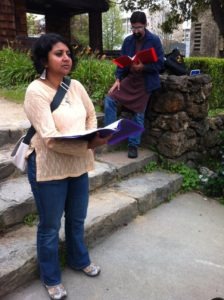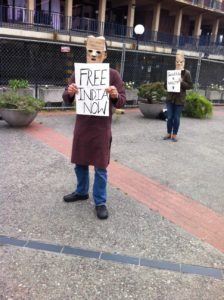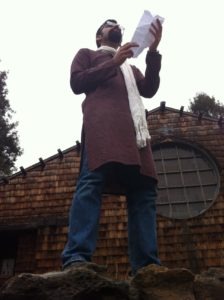
This is the story that launches Barnali Ghosh and Anirvan Chatterjee’s Berkeley South Asian Radical History Walking Tour, a Zinnian, two-hour walk through sites around the city where ordinary South Asians, many of them immigrants, mounted small revolutions, some of which are intertwined with watershed global events like 9/11 and the liberation of India from British rule.
Eloquently scripted and interspersed with enactments, poetry, and personal observation, the tour includes figures like Ishtiaq alongside turn-of-the-century anti-imperialist student organizers, because “we wanted to show as many different modes (of activism) as possible,” said Chatterjee.
But there’s a subtext to their choice of stories, one that underlies a modifying word in the tour’s title. “Radical,” for some South Asians, is a notion freighted with negativity, an identity that doesn’t necessarily merit aspiration. This perhaps isn’t a surprise when you consider South Asian communities’ history of embracing the compliant, hard-working “model minority” stereotype. Once you get beyond the mid-century apex of Gandhi’s freedom movement, many South Asian parents — particularly those who came here on professional visas — tend not to celebrate those who foment revolutions, personal or otherwise.
Historian Vijay Prashad has described this generation as the beneficiaries of State Selection, and described a dilemma he observed among their children as “second-generation South Asian American progressive youth who had a real hard time being radical desis. Many felt that to be desi was to be conservative, and to be radical was to be not desi.”
One intent of the tour, Chatterjee acknowledges, is validating South Asians who’ve pursued activism that their communities might deem extreme, naive, or pointless. “We think the tour works in different ways for different audiences … for (progressives), we want people to feel, ‘There’s 100 years of history I”m building on top of.’” But he adds that they’ve learned the tour resonates differently for various audiences, and for instance, that hearing these stories sometimes inspires elders to share their own experiences as the first in their communities to come to the States. “We don’t want it to feel like an indoctrination.”

A moment during a tour in April provided a glimpse into the trick of navigating this framing. On the march up Telegraph Avenue to UC Berkeley, where the tour proceeds geographically, rather than chronologically, Chatterjee paused to address the group with the coda to Tinku Ishtiaq’s story.
He began by explaining that to help care for an ailing family member, Ishtiaq eventually moved home to Bangladesh, where he was openly dating a younger man.
Then a question burst forth from a member of the group, interrupting him. “Do they have any danger to their life, or do they have security guards outside their homes … because any Muslim terrorists could issue a fatwa against them?”
Chatterjee, who’s participated in years of post 9/11 anti-scapegoating work both inside and outside Indian communities, didn’t miss a beat, deftly sidestepping the stereotypes embedded in the question, and referring back to his interview with Ishtiaq. “He says that money solves a lot of problems.” Now the crowd laughed, relaxed, and the questioner emphatically chimed in “it does!”
Having returned from the U.S. and owning a software company buffered Ishtiaq from discrimination to some degree, Chatterjee explained. But, he continued, “whether you like who he loves or not doesn’t matter, because he was the child who took care of his family. And in our community, that counts for a lot.”
In moments like that, he explained later, “it helps a lot that we’re not talking about abstractions.” They pair avoids being drawn into political debate by arming themselves with enough background information about their subjects to introduce texture that can illuminate the backdrop of a given story, instead.

In many respects, the walking tour represents a different mode of activism (“proactive, non-confrontational, and open-ended,” Chatterjee said) than the activist work that Chatterjee and Ghosh cut their teeth on. The pair has worked on issues that span anti-immigrant legislation, air travel’s impact on climate change, and youth organizing. They got the idea for the tour after they married, and were together engaging in activist work and delving further into local South Asian history.
“It’s a way to open up and normalize conversations on topics like feminism, civil rights, anti-racism, and LGBT equality,” said Chatterjee. “If those conversations take place, and audience members can come to understand the choices made by the people in these stories, then we’ve succeeded.”
This sentiment was reflected by an audience member at April’s tour, Vinaye Misra. “History’s interesting, because sometimes we have this naive belief that society is moving in a more progressive direction. The flip side of that is we tend to think that the people that came before us weren’t as progressive. The truth is, the more you learn about history like this, the more you realize is that they were pioneers in their own way. Your job is to learn that you’re standing on their shoulders.”
For more information on the Berkeley South Asian Radical History Walking Tour and upcoming dates visit the website. Photos courtesy of the writer. You can follow Nishat Kurwa on Twitter @nishatjaan.













1 thought on “Berkeley Walking Tour Opens Up The Conversation On South Asian Radical History”
Comments are closed.